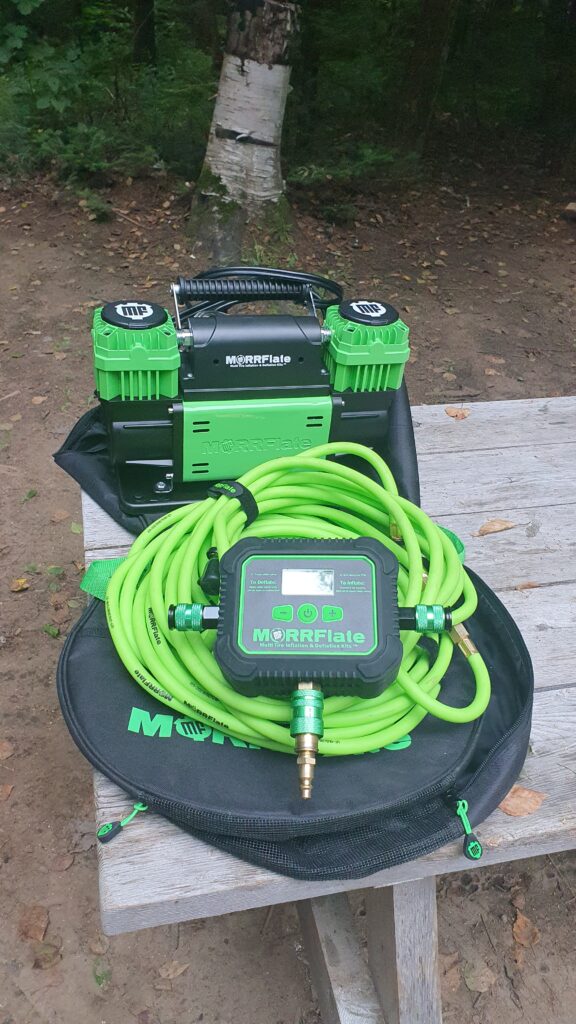
If you’re new to off-roading, it won’t be long before you’re told of the need to air down your tires when hitting the trails. For the beginner, tire pressures are often overlooked, but for those who are more experienced, it’s a very important consideration, and depending on your equipment, it can either be a time consuming chore, or a task that takes only a few minutes. We’re very fond of the MORRFlate tire management systems but more about them can be found in other posts on our page.
But why do it at all? Well for one thing it will provide a much smoother ride. Our tires are an important part of our ride comfort while off-roading, along with the rest of our suspension. When we lower our tire pressures, the tires themselves absorb a lot of the small bumps that we drive over while on the trails. Bumps from small rocks, or branches aren’t felt nearly as much with lower tire pressures. Lower tire pressures reduce the shock loads and stresses on your entire suspension system, which your vehicle will appreciate, and so will your back, and your wallet.
Another reason is that by lowering the tire pressures, it elongates the tires contact patch and increases the amount of the rubber on the ground. It may look like you also get a wider contact patch but that isn’t really the case. It only looks that way because the sidewall swells out so much. The truth is that the increased grip is stretched front to back, and not sideways. This added contact patch greatly increases your ability to climb rocks, boulders, and steep slopes. It also allows the tire to deform around rocks, and logs thus allowing for that added grip. It also reduces the risk of punctures. Tire damage is by far the most common type of trail damage. Are you properly equipped to do tire repairs on the trail? That’s a topic for another post (click here).
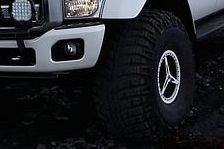
And finally, a larger contact patch greatly protects the ground and the environment overall. If you look at some of the 4x4s that are used in Iceland, the tires are extremely large, and run with extremely low air pressures. Running pressures as low as 5psi is quite common, and it allows the tire to drive over even delicate flowers without damaging them. It also makes them ideal for driving over deep snow by allowing the vehicle to float on top of the snow instead of sinking into it. Much like how a snow-shoe helps you walk on top of the snow instead of sinking down to your waist.

How low? Now that’s a difficult question to answer, and depends on a great many factors. Even tire manufactures can’t tell you how low to set their tires for off-roading. They have no idea what vehicle you have, or what type of terrain you’re tackling, or how heavy your vehicle is while loaded down full of gear. All you can do is experiment to find out what’s best for you. If you don’t air down enough, you won’t get all the benefits, but if you air down too much, you run the risk of damaging the tire, or breaking the bead (pulling the tire off it’s seat on the rim).
Breaking the bead isn’t the end of the world, if you have the skills and equipment to deal with it, but it’s a huge pain in the butt. And you can’t drive on it like that… it’ll ruin the tire, and damaging the tire should be avoided obviously. A safe number to lower your tires to would be 20psi. Lots of people go lower but 20psi is a safe place to start, and it’s at this pressure when most tires start to deform enough to start providing some benefits. However, if your rig is really heavy, you may want to start with a higher number. If your normal tire pressure is 50psi, then maybe start with 30psi. As a guideline, try dropping by 15-20psi and see how things go. No promises here folks… from off-road rigs to racecars, tire pressures is like a dark art. It takes a lot to figure out.
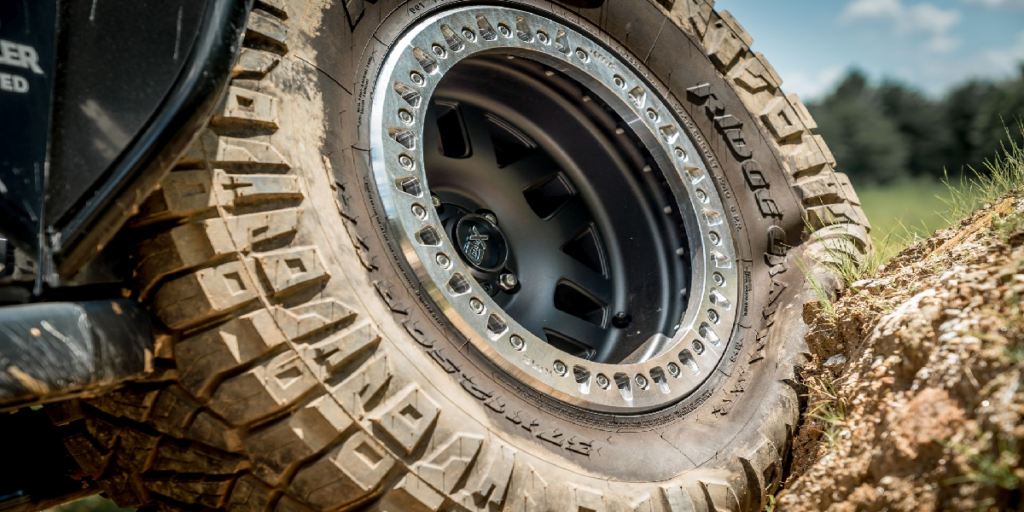
Sometimes you’ll hear people say “I run at 10psi (or less) all the time”, and that’s true, many people do. But they usually have bead-lock rims that prevent the bead from being broken. So if you hear someone say that, ask them if they are using bead-locks. I don’t have bead-lock rims, and I still run as low as 12psi without issues. But my specific tires with their reinforced Kevlar sidewalls, allow me to do that. My driving style also plays a huge role in that I’m not especially abusive on my equipment.
Whether or not you need bead-lock wheels really depends on how much off-roading you do. I go off-roading most weekends during the summer, and I personally don’t feel the need for them. My Jeep is still street legal and driven daily. Bead-lock wheels are generally more reserved for purpose built, hard-core rigs and buggies. They are also pretty expensive, and they do require regular maintenance. You should check your local laws though because in many places (in some States in America for example), they are prohibited for use on public roads.
You should also note that lowering your tire pressures will also lower your ride height, so you may find yourself scraping the bottom of your vehicle more often, and you’re more likely to get caught up on things like rocks, logs, etc. This was a huge motivation for installing a full skid plate system on my vehicle.
What about airing up again? Once again the question of “how much?” is a common one. This is a bit easier to answer…go by the recommended pressure on the placard found on the inside of your door. Now before anyone starts with the “Yeah but…”, please keep reading.
*This is where I upset the Internet and thousands of “experts”.
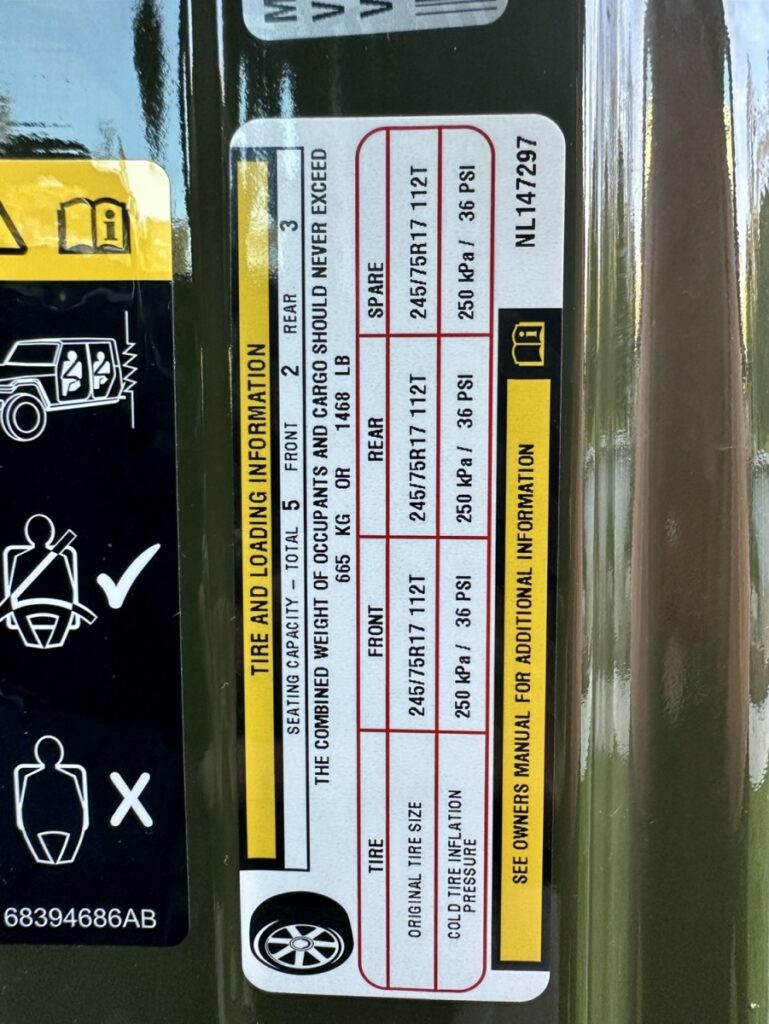
A lot of debate comes up here because the recommendations found on the door placard are for stock tires on a stock vehicle, and many people will tell you that those numbers are incorrect once you put on bigger tires. Not exactly true. Those bigger tires are rated for similar loads and usually more. So going with bigger tires, means that you can probably use a slightly lower psi setting. Unfortunately many people will tell you that bigger tires need more psi. Nope.
For example, my vehicle came with 33″ tires but it was designed for smaller, and can physically fit a 35″ tire before needing a lift kit. The recommended tire pressure remains the same. But the ‘experts’ say I need to increase the psi for bigger tires! Well, once again… just because you see it on YouTube, it doesn’t make it true.
Also, just because a 35″ tire will fit, it doesn’t mean the tire was designed for the weight of my Jeep. A 35″ tire is actually designed for a heavier vehicle. My Jeep recommends a psi of 36, so with a 35″ tire, I could safely set my tires to 32psi. But my vehicle is actually quite heavy with all the extra equipment I have added, and with all the gear I carry, so now I have to bring my pressures back up to compensate.
Confused yet? No? Read on…
You will also probably hear of the “chalk test”, and if you look this up on YouTube, you will find countless videos from ‘experts’ explaining how to do it. They’re all wrong though. The method they show only determines a pressure that demonstrates that the tire wear is equal across the tread patch when driving or braking in a straight line. It doesn’t take into account lateral cornering loads. If you’re like most people… you turn a lot.

The ideal on-road tire pressure is one that maintains the maximum traction (contact patch) under all on-road driving situations. That includes more than braking in a straight line on some quiet side road. It’s about keeping the maximum contact patch on the ground while minimizing sidewall flex. The “chalk test” shown on YouTube doesn’t establish that at all.
If you ask a racecar driver, or their mechanic, how to perform a chalk test, they will provide very different instructions. In short, the proper way to establish your tire pressures is under maximum lateral load while turning to ensure maximum contact patch on the ground, while under maximum lateral G-Load, without lifting the footprint (contact patch), or rolling onto the sidewall. It’s a balance of sidewall roll, and contact patch lift. Chalk is also used, but not along the width of the tread, but rather on the sidewall to visualize the amount of sidewall flex. This is a matter of establishing on-road performance that isn’t known by most off-road experts, who are experts at… you guessed it… off-road performance.

This is something you need a large open space for, like an empty parking lot (not just an empty side street to accelerate and brake in a straight line). Unfortunately, YouTubers tend to just regurgitate what everyone else says, even when it’s wrong. They just need content for views, likes, and subscribers. Proper research isn’t a priority.
By following the advice of all these YouTubers, you will end up with tire pressures that have a tremendous amount of sidewall flex. This can allow for lifting of the tread, thus reducing the contact patch, and leaves you with much less grip in the corners. Even worse is that the sidewall can collapse, and the vehicle can roll over. Obviously this is pretty bad for normal driving. It’s a HUGE safety issue. So if you like the idea of dramatic loss in traction while cornering on highway ramps, or increased risk of a roll over, by all means….keep listening to YouTube “experts” on how to set your tire pressures.
Sometimes you may even want to set your pressures a few psi higher than what is shown on the door placard. This may be needed if you’re like me and are heavily laden with equipment, or perhaps you want to improve your fuel economy a bit. Just don’t set them lower than recommended (not by more than a few psi and only if you have larger tires designed for a heavier load). Driving at highway speeds, on under inflated tires, is extremely dangerous. It will negatively affect your handling, and the tires are at risk of delamination (a blow-out). It’s for this exact reason why all modern vehicles have Tire Pressure Monitoring Sensors (TPMS) right from the manufacturer. They are required by law now.
If you’ve read this far, you realize now that this can be a complicated, and highly debated topic. Not only are there lots of conflicting opinions, but many people are quite absolute in their opinions. I’ll admit that I’ve added my own thoughts on this, and most off-roading “experts” will disagree with some of what I’ve said here. Some will even call me an idiot who doesn’t know what I’m talking about. Quite the opposite actually. My thoughts on this topic come from a very diverse knowledge and experience base (not just off-roading). It comes from a lot of tire testing across a wide range of tires, from a wide range of manufactures, on a wide range of vehicles, in all sorts of conditions. It comes from working with manufactures directly, and it comes from being a road safety specialist. Oh…I’m also a tire technician.
This is why I dislike the title “expert”, and why I avoid calling myself one. It suggests that there is a finite amount to know on a topic and that someone (an expert) knows all of it. Even a tire engineer at a specific tire company doesn’t know everything, and that makes topics like this one difficult because the right answer has to come from a very wide range of knowledge. However, listening to the advise found from 50 YouTube videos all saying the same thing doesn’t count.
Tires are the most scientifically engineered part of our vehicles, and we don’t generally think about them enough. Although off-roaders do pay more attention to their tires than most. Personally, I make a point to know as much as I can about tires in general. It’s become prerequisite knowledge for me. I can’t know everything though, and I don’t claim to. I do know a lot more about tire design than most off-roading experts though. But if you want to know about off-road suspension kits and geometry, I’m not the guy to talk too. I am also quite familiar with a lot of the incorrect information out there about tires, and I’ve discussed some of that here (like the chalk test). In the end though…you will have to make your own choices, and when it comes to setting your tire pressures for your off-road adventures, you will have to experiment.


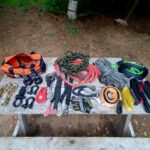 Previous Post
Previous Post